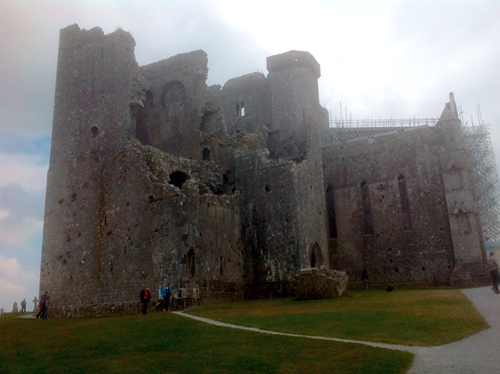A tour of the 11th Century [Rogue Nomads]

This is part 27 of Dee’s grey nomad adventure around Europe. To read her previous instalment, click here
The next day began by visiting the Rock of Cashel; it was the original seat of the Kings of Munster from the 11th Century. It is high on a hill (more climbing!); around 300 ft above the rocky plain which is called The Golden Vale of Tipperary. “Cashel” means fortress. According to Irish legend, the Rock of Cashel appeared as a result of the devil biting a mountain called the Devil’s Bit, and dropping some of the rock out of his mouth, but then St Patrick came to the rescue and banished the devil from his cave in the mountain. It has a 98ft tall round tower, built in 1101.

There are so many of these across Ireland, serving as watch towers and shelters from the Vikings. For me the interesting part was the High Cross, the Cross of St. Patrick, of which a copy stands in the courtyard. It has carvings of a crucifixion scene on one side and of St.Patrick on the other. Legend has it that if you hug the cross and you are single, you will find your soul mate that year. A couple of German tourists had a go.
There’s also a chapel, started in 1127, with a distinct German “look”, which is not surprising as some of the builders came from Germany! Lots to see there.
Even though there was nothing in the guide books about it, I noticed on my detailed map what looked like a priory icon a few miles away, towards Tipperary, so being intrepid, we went in search of it. It’s called Athassel Priory. Wow, and double wow! We found it on an out of the way road, just past a village called Golden. To get to the village we had to climb over a wall, and under some wire.
These ruins were enormous. We spent a long time looking around, as we had the place to ourselves. It was so big, and the whole place was wild. You can clearly see the carvings in the brickwork, one of which appears to be a headless Jesus. Discovered later that it’s the biggest priory in Ireland, dating back to the 12th century, and outside the walls a medieval town had grown. I have to say that the whole time I was there I felt a sense of foreboding, and a feeling as if I was being watched.
Next on my list was Fethard, again it’s not mentioned much in the guide book and it was quite a long drive. It was certainly worth it, it’s a medieval walled town, with 90 per cent of the wall still standing, and an Augustinian Abbey, still in use. We were told the countryside around the town is still as it was 800 years ago. What I wanted to find was one of the Sheelana Gig carvings. These are medieval carvings of women in erotic poses, and after much walking around we found one in the wall of the Augustinian Abbey. It’s only just over a foot tall, and I couldn’t see what was “rude” about it. Maybe you can?
Last but not least, after travelling through miles of thoroughbred horse country, we stopped, quite by chance, after seeing a sign to St. Segna’s healing well. It is behind the old Clonbeg church, and is said to heal ailments, in particular eye ailments. There are quite a few such healing wells in the area. For St. Segna’s healing to work you must tie a part of the afflicted person’s clothing to a nearby tree, as you can see from my photograph.
So a full, and very interesting day.
Have you been on a similar trip? Are there any beautiful landmarks that you have seen or stumbled upon? Tell us below!








 Proudly Australian owned and operated
Proudly Australian owned and operated